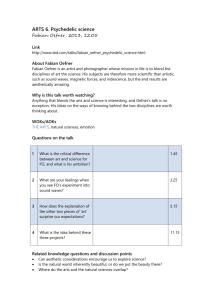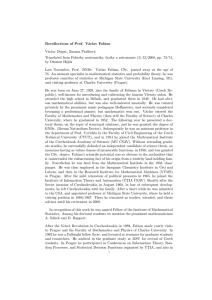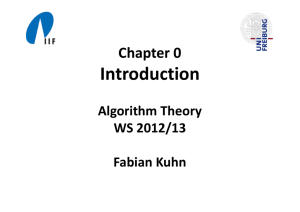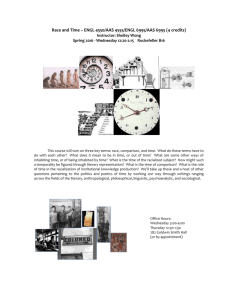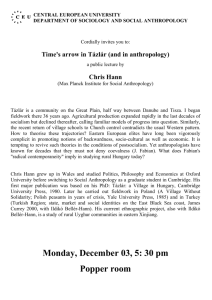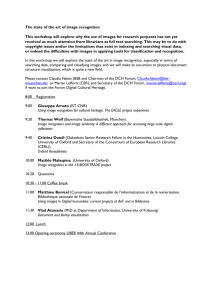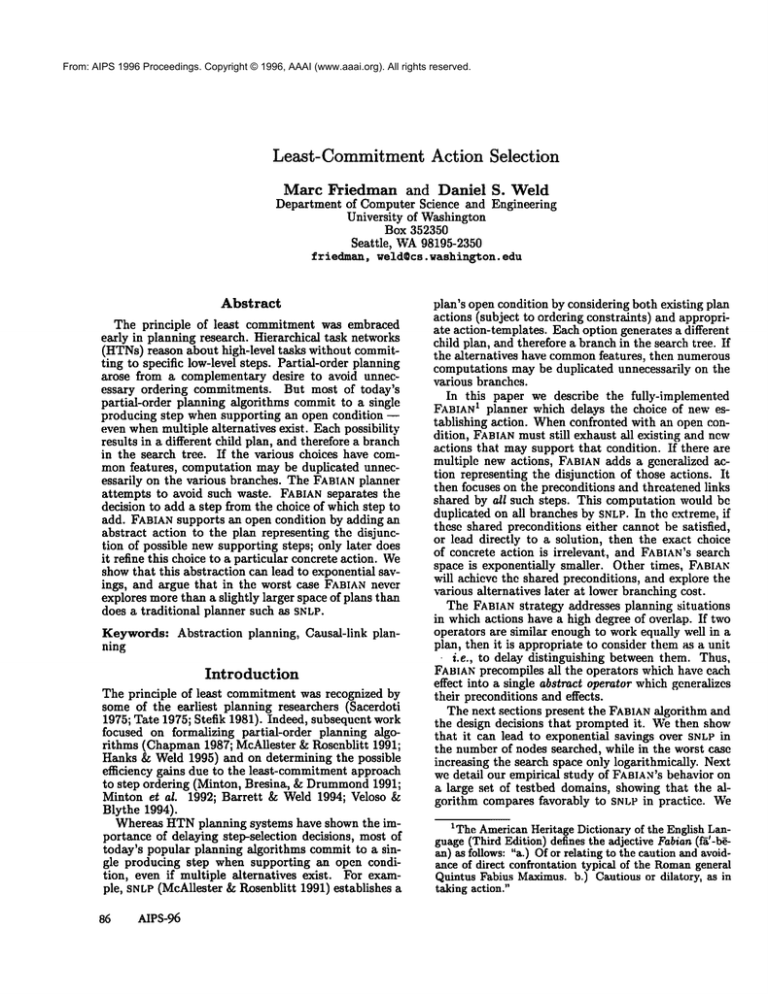
From: AIPS 1996 Proceedings. Copyright © 1996, AAAI (www.aaai.org). All rights reserved.
Least-Commitment Action Selection
Marc Friedman
and Daniel
S. Weld
Department of Computer Science and Engineering
University of Washington
Box 352350
Seattle, WA98195-2350
friedman,weld@cs.washington.edu
Abstract
The principle of least commitment was embraced
early in planning research. Hierarchical task networks
(HTNs)reason about high-level tasks without committing to specific low-level steps. Partial-order planning
arose from a complementary desire to avoid unnecessary ordering commitments. But most of today’s
partial-order planning algorithms commit to a single
producing step when supporting an open condition -even whenmultiple alternatives exist. Each possibility
results in a different child plan, and therefore a branch
in the search tree. If the various choices have common features, computation may be duplicated unnecessarily on the various branches. The FABIAN
planner
attempts to avoid such waste. FABIANseparates the
decision to add a step from the choice of which step to
add. FABIAN
supports an open condition by adding an
abstract action to the plan representing the disjunction of possible new supporting steps; only later does
it refine this choice to a particular concrete action. We
showthat this abstraction can lead to exponential savings, and argue that in the worst case FABIAN
never
explores more than a slightly larger space of plans than
does a traditional planner such as SNLP.
Keywords: Abstraction
ning
planning,
Causal-link
plan-
Introduction
The principle of least commitment was recognized by
some of the earliest planning researchers (Sacerdoti
1975; Tate 1975; Stefik 1981). Indeed, subsequent work
focused on formalizing partial-order
planning algorithms (Chapman 1987; McAUester & Roscnblitt 1991;
Hanks & Weld 1995) and on determining the possible
efficiency gains due to the least-commitment approach
to step ordering (Minton, Bresina, & Drummond1991;
Minton et al. 1992; Barrett & Weld 1994; Veloso &
Blythe 1994).
Whereas HTNplanning systems have shown the importance of delaying step-selection decisions, most of
today’s popular planning algorithms commit to a single producing step when supporting an open condition, even if multiple alternatives exist. For example, SNLP(McAllester & Rosenblitt 1991) establishes
86
AIPS-96
plan’s open condition by considering both existing plan
actions (subject to ordering constraints) and appropriate action-templates. Each option generates a different
child plan, and therefore a branch in the search tree. If
the alternatives have commonfeatures, then numerous
computations may be duplicated unnecessarily on the
various branches.
In this paper we describe the fully-implemented
1 planner which delays the choice of new esFABIAN
tablishing action. Whenconfronted with an open condition, FABIAN
must still exhaust all existing and new
actions that may support that condition. If there are
multiple new actions, FABIAN
adds a generalized action representing the disjunction of those actions. It
then focuses on the preconditions and threatened links
shared by all such steps. This computation would bc
duplicated on all branches by SNLP.In the extreme, if
these shared preconditions either cannot be satisfied,
or lead directly to a solution, then the exact choice
of concrete action is irrelevant, and FABIAN’S
search
space is exponentially smaller. Other times, FABIAN
will achieve the shared preconditions, and explore the
various alternatives later at lower branching cost.
The FABIAN
strategy addresses planning situations
in which actions have a high degree of overlap. If two
operators are similar enough to work equaily well in a
plan, then it is appropriate to consider them as a unit
i.e., to delay distinguishing between them. Thus,
FABIAN
precompiles all the operators which have each
effect into a single abstract operator which generalizes
their preconditions and effects.
The next sections present the FABIAN
algorithm and
the design decisions that prompted it. Wethen show
that it can lead to exponential savings over SNLPin
the mlmberof nodes searched, while in the worst case
increasing the search space only logarithmically. Next
we detail our empirical study of FAmAN’S
behavior on
a large set of testbed domains, showing that the algorithm compares favorably to SNLPin practice. We
1The AmericanHeritage Dictionary of the English Language(Third Edition) defines the adjective Fabian(tR’-b~an) as follows: "a.) Of or relating to the caution and avoidance of direct confrontation typical of the Romangeneral
Quintus Fabius Maximus.b.) Cautious or dilatory, as in
taking action."
From: AIPS 1996 Proceedings. Copyright © 1996, AAAI (www.aaai.org). All rights reserved.
PLAN (FROB, OPS, FLAWSELECT,REFINE)
Let ToVisit --- {NulIPIan(PROB))
While ToVisit is not empty do
REMOVE
a partial
plan 7) from ToVisit
If ~ has no flaws, return
Else
Use FLAWSELECT
to pick flaw
D, .flaw, OPS) to ToVisit
Add REFINE(~
Fail
Figure 1: A generic refinement planner.
conclude with a discussion of related and future work.
Planning
Algorithm
A refinement planner (Figure 1) takes four inputs:
planning problem, PROS,composed of an initial state
and a conjunctive goal; schemata for the available actions OPS; a flaw selection function FLAWSELECT;
and
a refinement function REFINE. 2 The planner searches
the space of partial plans and returns either a solution or "Fall" indicating that there is none. Since each
partial plan represents a set of totally ordered, completely specified action sequences, the refinement function splits the implicitly represented set along the axis
chosen by the flaw selection function (Kambhampati,
Knoblock, & Yang 1995). The planner starts from
the null plan corresponding to the set of all action
sequences, 3 and splits it into ever more constrained
sets until it can verify that one contains a solution.
The devil is in the details: the performance of any instance of such a planner varies widely depending on the
flaw selection strategy, the refinement function, and
the search technique. In the next two sections we describe the refinement functions that differentiate SNLP
and FABIAN.Our comparative analysis is independent
of search strategy, but assumes related flaw-selection
strategies.
Refinement in SNLP and FABIAN
The refinement
functionof SNLP, a soundand complete,systematic,
partial-order,
causal-link
planner,
is sketched
in Figure2. SNLP’splanrepresentation
contains
a partially
ordered
setofpartially
boundactionsanda setof causallinks.
A causal
link,denoted
Ap~Ac,recordsan irrevocable
commitment
to protectthegoalg duringtheinterval
between
execution
of theproducing
action,
Ap,andtheconsuming
action
A¢. SNLP plansmaybe fiawedin twoways:conditions
may be open,or linksmay be threatened.
WhenSNLP
refines
an opencondition,
it mustconsider
everyexistingactionandpotential
addedactionwhoseeffect
mayestablish
thecondition.
2Weignore
theplanselection
function
which
governs
the
nondeterministic
search
inthispaper.
3Thissetisencoded
asa planwithtwodummyactions:
Aohastheinitial
conditions
asitseffects,
whileA~has
theproblem’s
goalas precondition.
SNLPREFINEMENTS(P,
.flaW, OPS)
Case type(.flaw):
OpenCondition:
For each existing or new action Ap
producing g
Return a new plan that adds to P:
the causal link Ap~Ac
the action Ap, if it is new,
any new bindings and orderings
any new threats and subgoals of Ap
Threat:
Return if consistent:
(Promotion) P with {A¢ At ), and
(Demotion) P with {At < Ap)
Figure 2: The SNLPrefinement algorithm.
FABIANREFINEMENTS(~,f, ABSTRACTS)
Case type(f):
OpenCondltion: f = (subgoal g of step Ac)
For each existing action Ap producing g
Return a new plan that adds to 9:
thecausallinkAp~Ac
any new bindings and orderings
and any new threats,
restricting Ap to consistent actions
And also return one plan adding to ~v:
sthe unique abstract action A
the causal link As~Ac
orderings,
bindings, and subgoals of A
s
Threat:
{Same as SNLP)
Abstract:
.f = an abstract
actionA
Return
each
consistent
concretization
Z of A
s
in whichallreferences
to As arereplaced
withZ, addingany newthreats,
bindings
andpreconditions.
Figure 3: The FABIANrefinement algorithm.
Since SNLPcreates a new plan for each alternative
added step, in future planning it is committed to that
branching choice. A considerable amount of reasoning
may be duplicated on each branch, but SNLPwill grind
through them all. Even careful flaw ordering cannot
prevent all of this duplication.
A complete planner must consider all establishment
options, but it need not distinguish between them so
soon. The branching in some planning domains very
quickly overwhelms SNLP even for small problems. The
FABIAN
refinement algorithm (Figure 3) exploits commonfeatures of steps by separating the decision to add
a step, from the decision of tshich step to add. Delaying the latter decision decreases early commitmentand
branching. FABIANadds a single abstract
action A
s
representing the set of concrete actions with an effect
matching g (call this set ~qs). As functions as a disjunction over ~qs; FABIAN
adds to the plan only those
Friedman
87
From: AIPS 1996 Proceedings. Copyright © 1996, AAAI (www.aaai.org). All rights reserved.
constraints
required
by thedisjunction.
Preprocessing in FABIAN
Foreachgoalg, FABIANconstructs
a hierarchy
of abstractactionschemata
beforeplanning.
The rootof
thetreeis Og,theschemafortheentireset$g.The
leaves
aretheoriginal
concrete
schemata.
Theintermediatenodes,representing
thepropersubsets,
arecomputedas needed.Figure4 showsa samplehierarchy
for the predicate (cylinder ?x) with only one intermediate node shown.
Notice that while preconditions are formed from the
intersection of the preconditions of the children, the
effects
ofabstract
schemata
aretheunionoftheeffects
of theschemata
theyrepresent.
Theseeffects
may be
usedto establish
openconditions,
butonlythosein the
intersection,
whicharerendcrcd
in boldface,
cause
threats.
Thisdualtreatment
of effectsassures
that
constraints
introduced
by anabstrax:t
operator
areonly
thoserequired
byallof itschildren.
Considerestablishing
(cylindrical
rod).SNLP
triesaddingeachconcrete
actionindividually.
But
FABIAN adds an instance of Og (call this instanceA.q). FABIANthen adds the precondition
(free?type?machine)
to its set of flaws.It does
notconsider
(softrod)or (metalrod)at thispoint.
FABIANmnstfocuson whatallof the operators
have
incommon.
In thiscase,ifno freemachines
area~-ailableof any/type,
it willdiscover
thisfactonlyonce,
ratherthanthreetimes,andwillbacktrac.k
to some
morepromising
avenue.
Restricting
Setsof Actions
FABIAN
cart support an open condition with an effect
of an abstract action that is not common
to all its children. However,if FABIAN
continued to do so recklessly,
it wouldbe allowed to use multiple effects of an operator that were not supplied by any single child. So when
FABIAN
uses an effect of A0, it immediately restricts
the set of operators represented by A0 to consist only
of those that have the desired effect. Consider again
the example where the abstract operator As has been
added to establish (cylindrical rod). If 9 i s u sed
next to establish the open condition (hot rod), action
EXTRUDE
becomes inconsistent because it does not supply that effect. FABIAN
replaces As with an instance
of Rs, the disjunction of just LATHE
and ROLL.FABIAN
constructs Rs, and any other intermediate nodes, on
an as-needed basis.
The restricted plan P~ is more constrained than the
original, though it merely makes explicit constraints
that are already in the original plan P. Doing this
sort of constraint propagation may be an important
source of new flaws. Restrictions of operators may increase the set of preconditions (and therefore open conditions), and the intersection of commoneffects (and
therefore threats). In this case FABIAN
uncovered
new precondition,
(metalrod),whichmay be a crucialcluetothesolution.
Furthermore,
restriction
eliminatesinconsistent
planswhenever
no consistent
concretizations
remain.
88
AIPS-96
Concretization:
The New Refinement
Each abstract action in a plan constitutes an "abstract
flaw" that must be repaired eventually. Concretization repairs that flaw" by nondeterministically replacing it with one of its concrete descendents - the leaves
of the abstraction hierarchy. Each refinement further
constrains the plan, possibly adding open conditions,
threats, or bindings that arc present in the child but
not in the parent. Concretization obeys the refinement
property: if a partial plan P is concretized to P’: then
P~ represents a subset of the ground, totally ordered
plans that P represents (Kanlbhampati, Knoblock,
Yang 1995). Stated another way, concretizing cannot
remove constraints from a plan.
Design Choices
In summary, FABIAN
reasons about disjunctions of operators by precompiling abstract operators that generalize about domains. But its algorithm is not the only
conceivable one. Someengineering decisions which motivate FABIAN
are described below.
Intersections
FABIAN
uses a fast polynomial-time algorithm to compute conservative intersections of logical conjunctions.
Conjuncts must be exactly the same to bc in the intersection. Finding maximal intersections, on the other
hand, is isomorphic to finding S-sets in the version
space algorithm for generalization learning (Mitchell
1982).In this case, that algorithm must find graph isomorphisms as a subroutine, a procedure for which no
polynomial-time algorithm is known (Garey & Johnson 1979). The version space approach proved too slow"
in practice for some domains, despite the: small size of
the conjunctions.
Restrictions
FABIAN
only restricts an abstract operator producing
the effect used to support an open condition. However, any establishment refinement can add binding
constraints that make a concretization of some abstract action inconsistent. For example, suppose the
abstract action P contains action As. If open condition
(free ?type ?machine) of action s i s r esolved i n
such a way as to add the binding <?type = roller>,
then Ag’s descendents EXTRUDE
and LATHEbecome inconsistent, and Ag should be restricted to just ROLL.
It is possible for some domainsthat restricting operators when bindings are added may win. However,
preliminary results indicate that it is not usually profitable, so it is not implementedin FABIAN.
Concretization
Concretization increases the possible flaw selection options. Completeness
demandsonlythatall concrete
actions
beconsidered
- explicitly,
orimplicitly
through
abstractactionsabovethemin the hierarchy.
But
whichnodein theabstraction
hierarchy
shouldFABIAN
choose?
At oneextreme,
it mayinchdowntheabstractionhierarchy
bysplitting
thesetofleaves
intwo.Orit
From: AIPS 1996 Proceedings. Copyright © 1996, AAAI (www.aaai.org). All rights reserved.
may, on the other hand, concretize immediately to the
individual concrete actions. Wechose the latter, conservative approach, which limits the increase in solution depth. Thus FABIAN
can cut its losses in domains
where its blind abstraction policy is not profitable.
Flaw ordering
FABIANalways waits to concretize an abstract flaw
until all other flaws are resolved. It always repairs
flaws shared by concrete actions before unshared flaws.
Then it concretizes in LIFO order. Here FABIANaggressively seeks the minimumcommitment, a strategy
whose worst-case behavior is bounded as described in
the next section.
Comparison with the Committed
Approach
In this section we arguethat the space searched by
FABIAN
is never substantially larger than the space
explored by SNLP, but that in some cases SNLP’S search
space is exponentially greater than that of FABIAN.
Both planners make two kinds of choices: selection of
a plan to refine, and selection of a flaw (e.g., a specific
open condition) to repair.
Definition 1 A flaw selection strategy is a function
that mapsa plan to a flaw in that plan (or to _1_ if the
plan is a solution).
Whereas the search strategy requires backtracking
for completeness, the flaw selection strategy does not.
However, the order in which flaws are resolved is important - it determines what the search space/s. For
a meaningful comparison of the two planners, we force
SNLPto use a flaw selection strategy corresponding
to the one FABIAN
is using. For instance, if FABIAN
prefers threats to open conditions, and uses a LIFOordering within the categories, then we make SNLP pick
the same flaw that FABIANwould pick at the corresponding 4.
point in its search
Definition 2 (Search trees) Let T~4 be a planner
refinement algorithm, PROBbe a planning problem,
and F be a flaw selection strategy [or ~.A. Define
the search tree generated by T~4 on PROBgiven F,
SearchTree(T~4, PROB,F), to be a tree such that
1. the root is NulIPIan(PROB) and
,~. the children of a node are the refinements generated
by ~,A as directed by F.
A nodeis a leaf iff it is either a solution (i.e., all completions solve the planning problem PrtOB) or it is a
dead end (i.e., 7~A generates no children for the flaw
chosen by F).
Twofactors aifeet planner performance on a problem, regardless of the search strategy used: the perplan cost, and the number of plans searched. FABIAN
~This does not imply using the exact sameflaw selection
function that FABIAN
uses, but rather one derived from
it. SNLPhas a superset of FABIAN’S
flaws (minus abstract
flaws) to choose from at any given time.
spends a constant amount more time than SNLPper
plan, since it may restrict one abstract operator per
node. The number of plans searched, on the other
hand, depends on the branching factor, solution depth,
and solution density. FABIAN’S
salubrious effects on
these factors are summarized in Theorem 1.
Theorem 1 Let PROBbe a planning problem and F!
be a flaw selection strategy for FABIAN.Let T! denote SearchTree(FABIANKEFINEMENTS, PROB, Fy)
and suppose T! is finite. There e~ists a corresponding flat# selection strategy for SNLP,Fs, and a tree
T, = Search~ree(SNLPREFINEMENTS, PROB, F,)
such that
1. Depth(T!) _< 2 x Depth(T,)
2. Size(T/) %_ Depth(Ts) x Size(T,)
3. Size(Ts)/Size(T!)
may be exponential in the problem size
Proofi The proof hinges on the notion of plan correspondence, a mappingwhich is tedious to define rigorously. Informally, a plan in T! corresponds to a
plan in T, if the path to each from its respective root
node contains the same sequence of fiaw and repair
choices, except for concretizations. Wecan construct
F, from F! inductively, in a way that maximizes correspondence, as follows: Let Fa(NulIPIan(PROB))
FI(NullPlan(PaoB)).
Whenever v) is a n o pen
condition or threat, and 7)t ),
in T, corresponds to 7
choose F,(7 )’) = FI(P). Whenever Ff(7) ) is an abstract flaw, let F,(~v’) = Fl(child(79)) for the
)t.
with the coneretization matching 7
Part 1. An illustration
of T~ and T! for a simple
case is given in Figure 5. Here F! always chooses to
concretize right away. This corresponds to the strategy F, which establishes the same subgoais by just
adding the concrete steps in the first place. 7"I has
Cat most) two nodes (separated by a "link to abstract
action" refinement) for every one in T,. This construetion demonstrates that given T,, there is always a F/
generating a T! at most double in size, with corresponding nodes at most double in depth, since there
can be no more concretizations added along a path to
a plan than there are steps in that plan.
Delaying concretization will frequently make the
numberof nodes in T! far smaller, but there is no guarantee; the ratio Size(T/)/Size(T,)
may be as much as
Depth(T,), in trees where concretization
commonly
results in only one child with consistent bindings.
Part 2. (Worst case) To see why T! has at most
Depth(T,) times as many nodes as 7",, consider any
valid flaw selection strategy F! for FABIAN.F! can
concretize an abstract operator at any time between
its introduction and a point where there are no other
flaws. Weinductively construct F, from F/ as explained above, leading to the corresponding SNLPtree
T,. T! has two kinds of nodes: those with abstract operators but no other flaws (call them white nodes),
and the others (black nodes). The correspondence
between F, and F! leads to an inductively defined surjection, M, that maps every node of T, onto a black
Friedman
89
From: AIPS 1996 Proceedings. Copyright © 1996, AAAI (www.aaai.org). All rights reserved.
Og
ABSTRACT
for (cylindrical
?x)
precondition:(free ?type 7machine)
effect: (and(cylindrical ?x)
(not (painted?x))
(hot ?x)
(not (hot 7x))
(smooth?x)
Rg
(not (smooth7x))
?type = extruder
EXTRUDE
pre: (and(free extruder7machine)
(soft 7x))
eff: (and(cylindrical?x)
(not (painted?x))
(not (smooth?x))
(not (hot ?x)))
RESTRICTION to {LATHE, ROLL}
precondition:(and(free 7type?machine)
(metal?x))
effect: (and(cylindrical?x)
(hot ?x)
(not (painted?x))
(smooth7x))
(not (smooth?x))
?type= lathe
LATHE
pre: (and(free lathe ?machine)
(metal?x))
eff: (and(cylindrical?x)
(hot ?x)
(not (painted?x))
(not (smooth?x)))
Figure 4: Abstraction hierarchy for goal (cylindrical
node of T/. Distinct nodes of Ts may map to the same
black node, but every black node is the image of some
node in Ta, so Black(T/) _< Size(Ta). (M is surjective because every black node has at least one corresponding SNLPnode, or it would be inconsistent and
we assume consistency.)
The consistency assumption also ensures that every
white node has a consistent concretization, hence every
T1 leaf is black. There may be no more white nodes
on any path from root to leaf than there are steps in
that leaf plan, which is at most Depth(T~) - 1. Hence
Size(T/)
= Black(T/) + White(T/)
_< Black(T/)
Black(T/)(Depth(To)
<_ Depth(T,)Size(Ta)
Part 3. (Best case) Fabian tactics, properly applied, can reduce exponential search spaces to linear
ones. Consider an artificial
domain IDEAL-nwith n
pairs of identical operators {O:, O1,..., On, Otn }. Each
operator Oi has a single precondition Pi supplied by
the effect of Oi-z, so plans form a linear chain of length
n. To attempt to satisfy the goal Pn, whenP0 is false,
SNLP searches a complete binary tree of size 2" before
it realizes that Po is a necessary prerequisite for pn.
But as long as FABIAN
only concretizes when it can do
nothing else, it knows after only n steps! Moreover,
when no solution plan exists, there is no plan selection
or flaw selection strategy that will shave a single node
90 AIPS-96
ROLL
pre: (and(free roller 7machine)
(metal?x))
eff: (and(cylindrical?x)
(hot ?x)
(not (painted?x))
(smooth7x))
?x).
from SNLP’Sexponential search. A similar argument
applies to solvable problems with dead-end subtrees
structured like the IDEAL-nproblem.
[]
For infinite search trees, the analysis is substantially
the same. Wefind finite trees that are subgraphs of
the infinite search trees.
Corollary 2 (Infinite
search trees) Suppose T/ is
infinite. Define T, and M by induction. Consider any
finite connected componentT} of T! including the root
node. There is a connected component T" of T, which
Mmaps surjectively to the black nodes of Y~. Then all
three parts of TheoremI apply to T’f and T~.
Proof Sketch. T, and M are defined inductively
from any tree T/. Since the three parts of Theorem1
only depend on the mapping Mrelating the two trees,
it is sufficient to showthat Tj’ is connected (and thus
& tree). But by construction, M(parent(P)) is an
cestor of parent(M(P)) for any node n in T,. Thus
P E T~, so is parent(P).
Theorem 1 and its corollary show that FABIANhas
the potential for exponential speedup while risking
only a logarithmic (in the commoncase of bushy Ta)
slowdownin the worst case. But in some respects the
results are less satisfying than desired. In particular,
they only promise that for every FABIAN
flaw selection
strategy there exists a corresponding strategy for SNLP
that is not much better. For some domains, there may
yet be an SNLPstrategy that beats all FABIAN
strategies. This concern is real: since the precondition of
From: AIPS 1996 Proceedings. Copyright © 1996, AAAI (www.aaai.org). All rights reserved.
SNLP Search Tree
Fabian Search Tree
Link to abstract action
~
Link
ncretize
Link to abstract action
/~oncretize
Figure 5: Sample corresponding search trees for SNLPand FABIAN.
an abstract action is defined as the intersection of the
preconditions of its concretizations, FABIAN
can only
consider a subset of the open-condition flaws that are
available to SNLP. Since one commonform of domaindependent search control is a careful ordering of operator preconditions combined with a LIFOflaw selection
strategy (Williamson & Hanks 1996), FABIANmay
harder for users to control.
Another caveat concerns the proof’s assumption that
all FABIAN
plans have a consistent concretization. This
would amount to an NP-complete consistency check
at each node, which is not implemented. FABIAN’s
restriction procedure will catch those cases where the
constraints on a single abstract action rule out all of
its concretizations. However, there may be plans with
multiple abstract actions whose concretizations are all
mutually exclusive. The situation is analogous to arc
and path consistency in constraint satisfaction.
For
most domains we have studied, our arc-consistencylike implementation seems to be avoiding the pitfalls
of refining inconsistent subtrees.
Empirical
o
n°
u B/
[]/-.
"_
--Y..i/
-~ . -..o ~
¯
¯
o"
~_,p-’~. [] o~
1i0
100
" 1000
I0~00
100~00
Plans SNLPCreated (Ps)
Figure 6: Log/log scale graph of # plans created.
Investigation
The theoretical results we have presented depend on
SNLPusing a corresponding flaw selection strategy to
FABIAN’s.This is unfairly restrictive of SNLP.To see if
FABIAN’S
benefits would hold up in practice, we have
instead allowed FABIAN
and SNLP to use their default
flaw selection strategies. Wehave run them indiscriminately on all the domains we could find, and on a few
5(fewer than 10%) that we created.
Figure 6 shows the number of plans generated by
FABIAN
and SNLPfor 312 problems, with a search limit
of 20000 plans. The log/log scale best presents the
trends in a suite of problems varying so widely in difficulty. The 45 degree line divides those problems on
which FABIANdoes better (below) from those problems on which SNLPdoes better (above). The best-fit
$FABIAN is implemented
ontopof Baxrett’s
ucPoPversion4.0(Penberthy
& Weld1992),whichsubsumes
SNLP,
running
on a Silicon
Graphics
IndyunderAllegro
Common
Lisp4.2.BothFABIAN
andSNLPrepair
unseparable
threats
before
openconditions
before
abstract
flaws,
witha LIFO
ordering
within
thesegroupings.
Bothprefer
planswith
fewersteps+ flaws.
lineforthedatais logP!= .891ogPa,
witha degree
of confidence
(R2) of .8.Sincetheslopeis lessthan
one, FABIAN doesbetteron average,
andby a larger
marginon largerproblems.
Figure7 showsthe"internal
time"reported
by Lisp
for the same test runs.The data is visiblymore
chaotic,
butthelinearregression
is reassurin]$.
The
best-fit
lineis logT!= .91logTa- .06,withR~=.76.
Theslopeisjustslightly
closer
toone,despite
FABIAN’S
increased
per-plan
cost.
Theseresults
arequitepositive.
A lineon a log/log
graphwithslope.89disguises
justhow muchbetter
FABIANdoeson largeproblems;
if Ps = 20000,then
P/ = 6728.In fact,if we believe
thata straight
line
reasonably
approximates
the data,thenFABIAN’S
improvement
is exponential,
sinceP! = piSg.FABIAN
spendsa constantamountmoretimeper plandoing
restrictions,
butthiseffect
is dwarfed
by theimprovementFABIANis accruing
on the largeproblems.
We haveverified
FABIAN’Spotential
for exponentialspeedup
withtheartificial
domain
family
fromthe
proof.On the problemIDEAL-n,SNLP does indeed
Friedman
91
From: AIPS 1996 Proceedings. Copyright © 1996, AAAI (www.aaai.org). All rights reserved.
:,- .,:e
a
a
a~
a..
a
Oo[]
[]~a’o
[]a
[]
a
a
a~m lID
I1~
aaa
m
_
-
- .
¯
.
a
,
.
,
_
SNLPTimein milliseconds (Ts)
Figure 7: Log/log scale graph of internal times.
create and search 2n - 1 plans before failing, while
FABIAN
creates and searches only n of them.
The cost of operator precompilation is negligible.
Our preprocessor took .15 CPUseconds average on our
ten domains, or under one second of real time. Taking
unions and intersections of conjunctive formulae costs
O(n2) unifications in the domainsize.
Related
Work
Wementioned work evaluating the efficiency
that
planners could possibly gain by adopting a leastcommitment approach to action ordering (Minton,
Bresina, & Drummond 1991; Minton et al. 1992;
Barrett & Weld 1994; Veloso & Blythe 1994). Our
work applies the least commitment strategy to the
choice of new action to support an open condition.
Kambhampati’s formulation (Kambhampati 1992)
of the multi-contributor causal link approach originally
introduced in NONLIN
(Tare 1975) is also similar
our work since it adopts a reduced commitment approach to the specific producer of a causal link; essentially this amounts to supporting a consuming step
with a causal link containing a disjunction of concrete
steps. With FABIANevery causal link is supported
by a single producing step, but that step may be abstract .... i.e., represent a disjunction of concrete steps.
The approaches are actually orthogonal sohltions to
two different sources of combinatorial blowup. Multicontributor causal links merge partial plans containing the same steps but different causal links, while
FABIAN
merges plans with different stcps but the same
causal links. It would be interesting to combine our
appro,~whes.
Peot and Smith (Peot & Smith 1993) considered
different flaw selection strategies for SNLP-style planners. They showed that delaying consideration of certain threats could lead to search trecs that are sometimes smaller, but never biggcr than those of SNLI’. In
many ways, we were motivated by Peot and Sznith’s
92 AIPS-96
result;
unfortunately our upper bound is not as good,
sometimes consider a tree that is
larger than that of SNLP.Note that the approaches are
complementary, since we consider open condition flaws
while Peot and Smith addressed threats.
FABIAN
uses abstraction in a way radically different
from state-abstraction planners like ABSTR, IPS (Sacerdot[ 1974) and AB’rWEAK
(Yang & Tenenberg 1990),
which solve incrementally more and more concrete
planning problems using the previous abstraction as
a guide. State abstraction can cause exponential
speedup in certain regular domains (Knoblock 1992),
but it depends on the downwardrefinement property]
to prevent backtracking over abstraction levels. R~cently, Backstrom and Jonsson showed that there are
domains for whicJa the ALmNE
(Knoblock 1991) and
IIIPOINT (Bacchus & Yang 1994) algorithms may generate exponentially longer plans than optimal, despite
the downward refinement property (Backstrom & Jonsson 1995), because of the requirement that plans
build on solutions from previous levels. FABIAN’S
conservative abstractions never overconstrain plans,
so FABIAN
need not backtrack over abstraction decisions. Nor does it impose the restrictions of incremental search, as illustrated by our superior complexity
results. FABIAN
could certainly benefit, though, from
the state-abstraction notion of predicate criticality to
improve its abstraction decisions.
Kr,~mer and Unger (Kramer & Unger 1993) considered a form of abstract planning which is conceptually very similar to the FABIAN
approach. But Kramer
and Unger’s system used a domain-specific, manuallycreated hierarchy of abstract operators in contrast to
FABIAN’Sautomatic compilation algorithm. It is unclear if Kramer and Unger’s system w~-q implemented,
but no empirical tests are reported. Furthermore,
in contrast with the strong result of our Theorem1,
Kramer and Unger do not attempt any analytic assessment of their approach’s benefit.
since
FABIAN must
Conclusions
and Future
Work
Wehave presented FABIAN,a planning algorithm that
exploits a new form of least commitment. Whensupporting an open condition, FABIAN
separates the decision to add a step from the choice of which step to
add. FABIAN’s polynomial-time preprocessing strategy constructs abstract operators for each predicate
in a domain theory. Later, when supporting an open
condition during planning, FABIANadds a single instance of an abstract operator instead of [)ranching to
consider all possible concrete actions. This abstract
action is refined to a particular concrete action when
necessary.
Weshow that in theory this abstraction can lead to
exponential savings, and pro,,’(; that in the worst case
FAmAN
never explores more than a slightly (roughly
logarithmic) larger space of plans than a traditional
planner such as SNLP. The power of this result is
tempered by FABIAN’S
additional source of inconsistent plans, and by the requirement of our analysis that
SNLPuse a corrcspomling flaw selection strategy to
From: AIPS 1996 Proceedings. Copyright © 1996, AAAI (www.aaai.org). All rights reserved.
FABIAN’S.Furthermore,
FABIANobfuscates
domaindependent
searchcontrol.
Although
FABIANinherently
hasmorediverseoptions
thanSNLPit hasdifficulty
capitalizing
on thesimplebut powerful
technique
of
precondition
ordering
thatSNLPusershaveexploited
to
encodetheirsearchcontrol
knowledge,
because
FABIAN
planshavefeweropenconditions
to choosefrom.On
theotherhand,it shouldbelesshindered
by poorprecondition
ordering by the programmer.
Our experimental results on a large test suite
indicate that the FABIANapproach performs better on average than SNLP. While the benefits are
significant,
they are not revolutionary.
Even if
FABIAN’S savings is exponential, we cannot do away
with domain-dependent
search control.
We may
have found a practical technique to improve domainindependent planning, but several serious problems remain before it will become widely adopted. Applying smarter domain-independent flaw selection strategies may make FABIAN’S
inability to exploit precondition ordering an advantage. Finally, extending FABIAN
tO handle quantification and conditional effects would
vastly expand the applicability
of least-commitment
action selection.
Acknowledgements
Many thanks to Tony Barrett,
Adam Carlson, Bob
Doorenbos, Oren Etzioni, Keith Golden, Steve Hanks,
Subbarao Kambhampati, Nick Kushmerick, Neal Lesh,
Greg Linden, Rich Segal, Ying Sun, and Mike
Williamson for helpful commentsand discussions. This
research was funded in part by Office of Na~dResearch
Grant N00014-94-1-0060, by National Science Foundation Grant IRI-9303461, by ARPA/ RomeLabs grant
F30602-95-1-0024, by a gift from Rockwell International Palo Alto Research, and by an NSF Graduate
Fellowship.
References
Bacchus,F., and Yang,Q. 1994.Downwardrefinementandtheefficiency
of hierarchical
problem
solving.Artificial Intelligence 71:43-100.
Backstrom, C., and Jonsson, P. 1995. Planning with
abstraction hierarchies can be exponentially less efficient. In Proc. 15th Int. Joint Conf. on A.I., 1599-1604.
Barrett, A., and Weld, D. 1994. Partial order planning: Evaluating possible efficiency gains. Artificial
Intelligence 67(1):71-112.
Chapman, D. 1987. Planning for conjunctive goals.
Artificial Intelligence 32(3):333-377.
Garey, M., and Johnson, D. 1979. Computers
and Intractability:
A Guide to the Theory of NPCompleteness. New York: W. H. Freeman and Company.
Hanks, S., and Weld, D. S. 1995. A domainindependent algorithm for plan adaptation. Journal
of Artificial Intelligence Research 319--360. Available
via FTP from pub/ai/at
fl;p.cs.washington.edu.
Kambhampati, S.; Knoblock, C.; and Yang, Q. 1995.
Planning as refinement search: A unified framework
for evaluating design tradeoffs in partial order planning. Artificial Intelligence 76:167-238.
Kambhampati, S. 1992. Characterizing
multicontributor causal structures for planning. In Proc.
1st Intl. Conf. on A.L Planning Systems, 116-125.
Knoblock, C. 1991. Automatically Generating Abstractions for Problem Solving. Ph.D. Dissertation,
Carnegie Mellon University. Available as technical
report CMU-CS-91-120.
Knoblock, C. 1992. An analysis of ABSTRIPS. In
Proc. 1st Intl. Conf. on A.I. Planning Systems.
Kramer, M., and Unger, C. 1993. A generalizing
operator abstraction. In Proceedings of the Second
European Workshop on Planning.
McAllester, D., and Rosenblitt, D. 1991. Systematic
nonlinear planning. In Proc. 9th Nat. Conf. on A.I.,
634-639.
Minton, S.; Drummond,M.; Bresina, J.; and Phillips,
A. 1992. Total order vs. partial order planning: Factors influencing performance. In Proc. 3rd Int. Conf.
on Principles of Knotoledge Representation and Reasoning.
Minton, S.; Bresina, J.; and Drummond, M. 1991.
Commitmentstrategies
in planning: A comparative
analysis. In Proceedings of IJCAI-91, 259-265.
Mitchell, T. 1982. Generalization as search. Artificial
Intelligence 18:203-226.
Penberthy, J., and Weld, D. 1992. UCPOP:A sound,
complete, partial order planner for ADL.In Proc.
3rd Int. Conf. on Principles of Kno~oledgeRepresentation and Reasoning, 103-114. Available via FTP
from pub/ai/at ftp. cs. wash£ngton, edu.
Peot, M., and Smith, D. 1993. Threat-removal strategies for partial-order planning. In Proc. 11th Nat.
Conf. on A.I., 492-499.
Sacerdoti, E. 1974. Planning in a hierarchy of abstraction spaces. Artificial Intelligence 5:115-135.
Sacerdoti, E. 1975. The nonlinear nature of plans. In
Proceedings of IJCAI- 75, 206-214.
Stefik, M. 1981. Planning with constraints (MOLGEN:Part 1). Artificial Intelligence 14(2):111-139.
Tate, A. 1975. Interacting goals and their use. In
Proceedings of IJCAI-75, 215-218.
Veloso, M., and Blythe, J. 1994. Linkability: Examining causal link commitmentsin partial-order planning. In Hammond,K., ed., Proc. ~nd Intl. Conf. on
A.I. Planning Systems, 170-175. AAAI.
Williamson, M., and Hanks, S. 1996. Flaw selection
strategies for value-directed planning. In Proe. 3rd
Intl. Conf. on A.L Planning Systems.
Yang, Q., and Tenenberg, J. 1990. ABTWEAK:
Abstracting a nonlinear, least-commitment planner. In
Proc. 8th Nat. Conf. on A.L, 204-209.
Friedman
95

